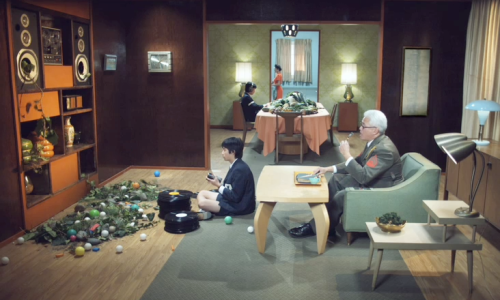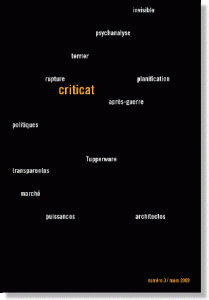Today I went nettouring and this is the best darn thing I’ve brought back from my travels…
 By Terri Timely, via Core 77
By Terri Timely, via Core 77
Today I went nettouring and this is the best darn thing I’ve brought back from my travels…
 By Terri Timely, via Core 77
By Terri Timely, via Core 77
Posted in fiction
Now that Beyond is showing up in reviews in Volume and Abitare it’s a good time to announce that, following the buzz on all the beyonds, I’ll be presenting the bookazine at the Beyond Media Festival, in Florence, on the 10th of July.

I’m proud to be talking alongside Piero Frassinelli, from Superstudio – whose 1971 essay on “Twelve Ideal Cities” was featured as a reprint in the Scenarios & Speculations issue of Beyond.
The talk is on “Writing and Vision – Between Reality and Fiction” and is one in a programme of many, including international speakers such as Derrick de Kherkove, Marcos Novak, Beatriz Colomina, Peter Lang and Frédéric Migayrou.
This image was floating on my desktop without any clear destination and I’ve thought it should land right here.

I can’t exactly remember where the image came from, but it was there on my desktop as a reminder of a media category that, specially in the field of architecture – but also maybe of music, the arts and the literary – captures extraordinary attention and dedication. It must be some tendency to cling to the glorious feel of those student days…
Cynthia Davidson and her endorsement for (a) small (portuguese) magazine back in 2004 immediately comes to my mind. But also, of course, Colomina’s Princeton research on the same subject, originating the “Radical Architecture of Little Magazines 196x-197x” exhibition in places like the Storefront for Art and Architecture, at the CCA and later at the AA, always around the nostalgia of the “legacy and influence of 1960s and 70s print culture.”
Now, I do think little mazines are still alive and kicking and there’s no reason to be mostalgic about some sort of primeval loss of a revolutionary printing spirit. Even in the midst of much web publishing the gloss and originality of small magazines lingers on – inside or outside the architecture field.
 It is true that “little magazines” like Casabella (yes, Casabella was on the exhibition) are now shrinking into oblivion – just like other referential publications met their end at the hands of a merciless publishing market. L’Architecture d’Aujourd’hui finished in 2007 – after 77 year of publication! – with a last issue on the ultimate surviving modernist, Oscar Niemeyer… Ironically, another last issue was announced on luxury in architecture, but I don’t think this has come out…
It is true that “little magazines” like Casabella (yes, Casabella was on the exhibition) are now shrinking into oblivion – just like other referential publications met their end at the hands of a merciless publishing market. L’Architecture d’Aujourd’hui finished in 2007 – after 77 year of publication! – with a last issue on the ultimate surviving modernist, Oscar Niemeyer… Ironically, another last issue was announced on luxury in architecture, but I don’t think this has come out…
But every other day, everywhere, new small magazines appear to carry the flame of independent radical thought – or simply the new trends that will soon go mainstream – even if only for the small print reading minority. Digital print-on-demand will also take care that this can always be the case.
I wouldn’t know where to start to pick up the interesting examples. So I left my first choices to pure randomness. And I ended up with this two little magazines…

Last wednesday, I lazily streched my hand from bed on to my bedside library and out came the premiere issue of SCRUB to enlighten my holyday lie in. I didn’t even know what this was about. Any premiere issue that looks vaguely interesting deserves an immediate place in my magazine collection. It didn’t take much time to realise, though, that this was a gay magazine that, while being published in Berlin back in 2006, was totally focussed on New York. (How’s that for a 70s revival?)
The very best piece there was undoubtedly a 32-page interview (how’s that for radical?!) with a 70s NY club-goer and fashionista that immediately makes you dive into the wild nightlife of an almost fictional pre-AIDS New York. I say, how’s that for youth nostalgics? My only disappointment came from the fact that a quick google revealed this one issue of SCRUB to be totally exposé online… Good news for those who feel like reading the Ruben Espinosa interview, though!
Another good (and more serious) read arrived through the snail-mail, and it was sent by Beyond’s contributor-to-be Valéry Didelon: another small magazine with important intentions, Paris-based CRITICAT.
 Currently displaying its third issue, Criticat appears because, as its editors say, there is still a need for magazines that, while offering a space for critical reflection, are actually not tied to institutions – such as, I would say, universities, museums and big media groups… – and are therefore open to the “other actors of intellectual and artistic life.”
Currently displaying its third issue, Criticat appears because, as its editors say, there is still a need for magazines that, while offering a space for critical reflection, are actually not tied to institutions – such as, I would say, universities, museums and big media groups… – and are therefore open to the “other actors of intellectual and artistic life.”
As such, this issue of Criticat again offers good food for thought on the return of modernism’s “others” (see my previous post). Somehow aligning with the very commendable sociologists that claim that late modernity never really left the scene – despite being under strong fire by post-modernist discourse – the magazine presents several interesting articles on the ideological recuperation of post-war modernism.
New heroes and narratives are discovered of course (as in the very interesting Marilena Kourniati revision of revisions), ideology itself is seen as a potential part of the problem, if not it’s Achilles heel (as in brilliant as usual Wouter Vanstiphout, whose article I discovered also here…) and, last but not least, the political implications of the architect’s action is brought back to actuality by Didelon’s own editorial note on how today we’re already dealing with the “au-delà du spectacle.”
Little magazines are still there to offer us the most radical visions of architecture and its cultural (dis)contents. The problem is to discover and identify them in the midst of all the pseudo-theoretical mumbo jumbo that, like some digital wallpaper, now surround us from all sides.